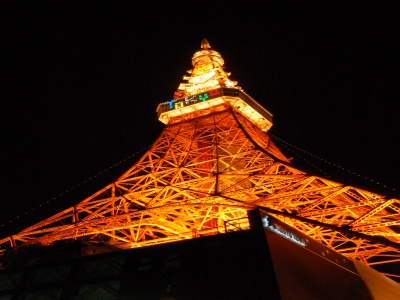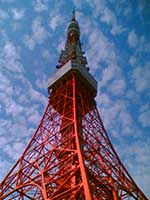Tokyo Tower

Tokyo Tower is a broadcast communications and observation tower that stands out as perhaps Tokyo’s most recognizable structure. Standing 333 meters, the tower is the world’s tallest self-supporting steel tower, and affords one of the city’s best views of Tokyo and the surrounding Kanto area.
![]()
Brief History of Tokyo Tower
Construction of the Tower was undertaken in 1957 when the Japanese government recognized the need for a communications tower to handle television broadcasting by NHK and other emerging stations, while at the same time avoiding cluttering the city with an eyesore of numerous transmission towers. The government also wanted to erect a symbol of Japan’s economic re-emergence from the aftermath of WWII.
The ambitious solution was to build a single, mammouth broadcast communications tower capable of broadcasting throughout the Kanto region. Renowned architect Tachu Naito drew inspiration from France’s Eiffel Tower, and the result, completed in 1958, was a steel lattice tower that indeed bears close resemblance to its counterpart in Paris.
![]()
Tokyo Tower Facts
 Height: 333 meters, making the Tower the world’s largest self-supporting steel tower. In comparison, the Eiffel Tower is 320 meters high.
Height: 333 meters, making the Tower the world’s largest self-supporting steel tower. In comparison, the Eiffel Tower is 320 meters high.
 Weight: approx. 4,000 tons. In contrast, the Eiffel Tower weights about 7,000 tons.
Weight: approx. 4,000 tons. In contrast, the Eiffel Tower weights about 7,000 tons.
 Color: Reddish orange and white, in compliance with the Civil Aeronautic Law. 28,000 liters, or 140, drums, of paint was used to coat the Tower. The Tower is repainted every five years.
Color: Reddish orange and white, in compliance with the Civil Aeronautic Law. 28,000 liters, or 140, drums, of paint was used to coat the Tower. The Tower is repainted every five years.
 Broadcast signals: 24 (14 analog and 10 digital). All of Japan’s major TV networks, including NHK, Fuji TV, TV Asahi, and Fuji TV, transmit their signals from the Tower.
Broadcast signals: 24 (14 analog and 10 digital). All of Japan’s major TV networks, including NHK, Fuji TV, TV Asahi, and Fuji TV, transmit their signals from the Tower.

 Lighting: 176 floodlights installed throughout the tower light up the tower at night. The Tower is illuminated in orange light during winter in order to provide a warming effect, and cool white light in the summer. The Tower is also ocassionally illuminated in other colors for special occassions.
Lighting: 176 floodlights installed throughout the tower light up the tower at night. The Tower is illuminated in orange light during winter in order to provide a warming effect, and cool white light in the summer. The Tower is also ocassionally illuminated in other colors for special occassions.
 Observation decks: the Tower has two observatories: the main observatory at 150 meters; and the Special Observatory at 250 meters. Thanks to a lack of obstructing high-rise structures near the tower, the observatories afford fantastic views of Tokyo’s cityscape and the Kanto region, and even Mt. Fuji on clear days.
Observation decks: the Tower has two observatories: the main observatory at 150 meters; and the Special Observatory at 250 meters. Thanks to a lack of obstructing high-rise structures near the tower, the observatories afford fantastic views of Tokyo’s cityscape and the Kanto region, and even Mt. Fuji on clear days.
 Other attractions: Tokyo Tower also houses additional attractions, housed in an area called Foot Town, which include a wax museum, Trick Art Gallery, and Guinnes World Records Museum, as well as gift shops and restaurants.
Other attractions: Tokyo Tower also houses additional attractions, housed in an area called Foot Town, which include a wax museum, Trick Art Gallery, and Guinnes World Records Museum, as well as gift shops and restaurants.
 Appearance in film and TV: Tokyo Tower frequently appears as a backdrop for film and TV. In 2007, a popular serial TV drama of the same name about a mother and son’s relationship as they deal with the mother’s cancer was broadcast on Fuji TV. The drama was later made into a full-length movie.
Appearance in film and TV: Tokyo Tower frequently appears as a backdrop for film and TV. In 2007, a popular serial TV drama of the same name about a mother and son’s relationship as they deal with the mother’s cancer was broadcast on Fuji TV. The drama was later made into a full-length movie.
![]()
Tokyo Tower Tourist Tips
Tokyo Tower is fun to visit during both the daytime and evening. Mt. Fuji is visible on clear days. At nightime, the view overlooking the city is fantastic, making it a romantic dating spot.
It is also fun to play “Where’s Waldo” with the prominent Tower and try to spot it from various locations throughout the city.
![]()
|
![]()
